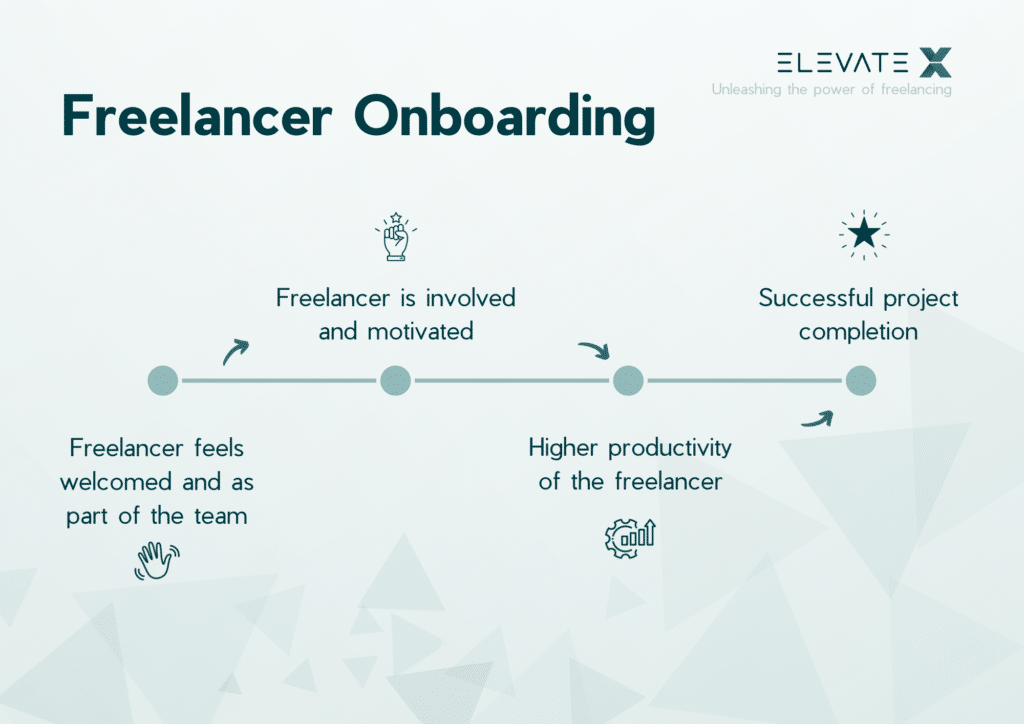Not all employees have to be permanent – 70% of small businesses in the USA use freelancers for their projects, and the number is also increasing in Germany. This is particularly true in the IT sector, where freelance specialists are increasingly employed. According to the 2021 IT Freelancers study by IDG Research Services, 78% of the surveyed companies used external labor in the field of information technology. High professional competence and flexibility are key reasons for employing freelancers. However, efficient freelancer onboarding is essential for integrating them into the company. This article provides a step-by-step guide on how to effectively onboard skilled freelancers and why good onboarding is important.
What is (Freelancer) Onboarding?
Onboarding refers to the process of integrating new employees into a company. In the context of freelancers, onboarding describes the steps to integrate external experts into projects they are to perform for the company.
Freelancer onboarding is a concept from the field of human resource management. It employs measures aimed at making it easier for employees to settle into the new company. Although freelancers are not permanent employees, structured onboarding is important. This ensures that freelancers understand the company’s expectations and are able to efficiently and effectively complete their assigned tasks, whether in software development, big data, or project management.
KEY POINTS
- Freelancer onboarding defines the process of integrating external employees into the company.
- Effective freelancer onboarding is advisable to achieve an emotional connection to the company and high motivation of the employees.
- For freelancer onboarding, it’s important to establish personal contact, provide company-specific information, and supply necessary tools for optimal task accomplishment.
Onboarding: Freelancers vs. Permanent Employees
The onboarding of permanent employees and freelancers differs in several aspects due to the different nature of the working relationship and expectations of these two groups. Welcoming someone who is only in the company for a limited time and often works from home can be challenging. It lacks personal gestures and team-building activities like a joint lunch, which are important for emotional bonding.
Also, practically, the remote training of competent freelancers presents challenges. Training external experts should be through a well-thought-out system. If this is not available, collaboration with e-learning specialists can be helpful. Moreover, it is essential to define clear expectations and attach them to a set timeframe. You should communicate clearly and understandably what needs to be done within a certain period.
External recruitment holds some difficulties that companies should be aware of. If these can be easily overcome in the company, innovative development through the employment of freelancers can be achieved.
Why Freelancer Onboarding is Important
Hiring new employees requires time, money, and commitment. Therefore, it’s in the interest of every company to retain suitable labor and avoid a high turnover rate. Fundamentally, the quality of training and emotional attachment to the workplace matter. This is true not only for permanent employees. A solid onboarding strategy is also important for external professionals. Failed onboarding results in:
- Delayed start dates for projects and services
- Repeated misunderstandings and necessary revisions causing frustration
- Lower participation and resulting withdrawal from the project
- Outstanding fees raised by freelancers due to delayed payments
With good freelancer onboarding, this can be avoided. New employees are prepared for their future tasks and responsibilities through targeted training and firmly integrated into the company. Regarding their integration into the team and the overall company culture, excellent onboarding also plays an important role.
Certain measures lead to freelancers..
- Feeling more welcome
- Being more involved
- Being more motivated to complete a project productively and successfully
An optimal onboarding process also allows setting clear expectations on both sides. This can save you problems later and avoid misunderstandings. Conveying a positive impression directly can significantly determine the rest of the collaboration.

Benefits of Effective Freelancer Onboarding
With ideal freelancer onboarding, you can achieve more productivity from external employees and secure competitive advantages. There are not many companies that implement good and smooth onboarding of freelancers. Thus, first-class onboarding offers the opportunity to stand out from competitors. Efficient freelancer onboarding ensures that new employees feel comfortable in the company and see themselves as part of the team. This way, the motivation to implement a project as well as possible, quickly, and according to specifications increases. If the deployed freelancer shows strong commitment, this generally brings advantages for the company.
- External employees feel part of the team
- Increased productivity of freelancers
- Better positioning against competitors
Find the Right Freelancer for Your Next Project!
How Long Should Freelancer Onboarding Take?
The duration of freelancer onboarding depends on various factors and can range from a few weeks to three months. You should avoid longer onboarding periods to prevent potential loss risks for the company. Moreover, a freelancer onboarding process lasting many months indicates that the processes for integrating external employees are not efficient and need improvement. However, when planning an orientation, you should still allocate enough time to cover the most important points on the checklist. Additionally, a timeframe for inquiries should be considered. After all, onboarding should be more interactive rather than predominantly instructive.
Step-by-Step Onboarding
Successful freelancer onboarding includes several steps. For a smooth process and effective project management with motivation, focus on creating an emotional connection to the company and precise communication of requested tasks according to schedule
Step 1 - Gather all Required Contract Data
The first step involves collecting important information about the freelancer and necessary data for contract completion. This includes:
- Full name, phone number, and email address of the contractor
- References of the external employee
- Tax identification number and payment information of the freelancer
To ensure timely payments, you should provide the necessary data to the finance team early. A delay in payment can jeopardize the working relationship and future collaboration.
Step 2 - Ensure Signing of Agreements and Secure Important Documents
In addition to the work contract, documents such as data protection and confidentiality agreements usually need to be signed. It makes sense to automate this step and use a special management program. This can make the process time-efficient, standardized, and ensure that all contracts and documents are stored in a secure place.
Step 3 - Organize a Personal Meeting
To achieve a better connection to the company, opt for personal contact instead of phone calls and email correspondence. If the freelancer can meet the people they will work with, it contributes to loyalty. Moreover, the external employee will communicate more openly the better they know their colleagues. If contact is only through written communication, this can diminish motivation for the project and interest in successful collaboration. Video chats can also contribute to a closer connection. It’s important to set a visual aspect to create more understanding and bonding.
Step 4 - Discuss Expectations, Goals, and Company Structures
Freelance employees need concrete guidance to successfully start the project. Precise information on how and when tasks are to be completed serves as a basic structure for the project. Your HR manager may not be fully informed about department-specific processes. Therefore, it’s a good idea to sit down with the relevant departments before hiring freelancers and create clear templates. These documents should contain all information that freelancers need for a successful start in the company. Contents could include:
- A specific plan for the project’s procedure and timelines.
- Who freelance employees should contact if they have questions about payments, processes, systems, or used tools. Ideally, provide names and email addresses of relevant contacts.
- If the company has specific conventions for file naming, then freelancers should also be aware of them. Additionally, inform about certain routines for interacting with projects and customers.
- Information on office hours, access codes, and security procedures is also essential if external workers are deployed on-site.
Presenting this information allows freelance employees to better prepare for their tasks and avoid unnecessary friction points. Always ensure that new employees know what is expected of them, who to contact with questions, and by when tasks need to be completed.
Step 5 - Adequately Equip Freelancers
Equip your freelancers with the relevant software and information they need to work remotely from day one. From necessary passwords and user names to important links and programmes, external employees should be able to access everything they need to carry out their tasks properly. This ensures smooth familiarisation and reduces complications during collaboration. You should take data protection into account here to ensure that collaboration takes place within the framework of legal regulations.
Step 6 - Solicit Feedback
It’s advisable to maintain constant contact with freelancers and consult them. During a collaboration, inquire about possible discrepancies and take signs of lack of engagement seriously. Soliciting feedback can help identify systemic issues with external employees and rectify them. Asking your contractors for occasional feedback serves to:
- Build trust on both sides
- Maintain high engagement
- Improve overall operational efficiency
Conclusion
Successful freelancer onboarding is marked by commitment on both sides. The ideal onboarding process clearly defines expectations and ensures the provision of important information and tools for the efficient completion of required tasks. Through personal contact with external employees, you can increase the bond to the company and the motivation of freelancers. Feedback discussions can identify discrepancies and eliminate them, achieving effective onboarding.
Freelancer onboarding encompasses all measures necessary for integrating external employees.
Optimal onboarding of freelancers ensures efficient collaboration and fosters high engagement of external workers.
Successful freelancer onboarding is conducted through training in the respective company project via personal contact, equipping with company-specific information, and necessary software and access data.








